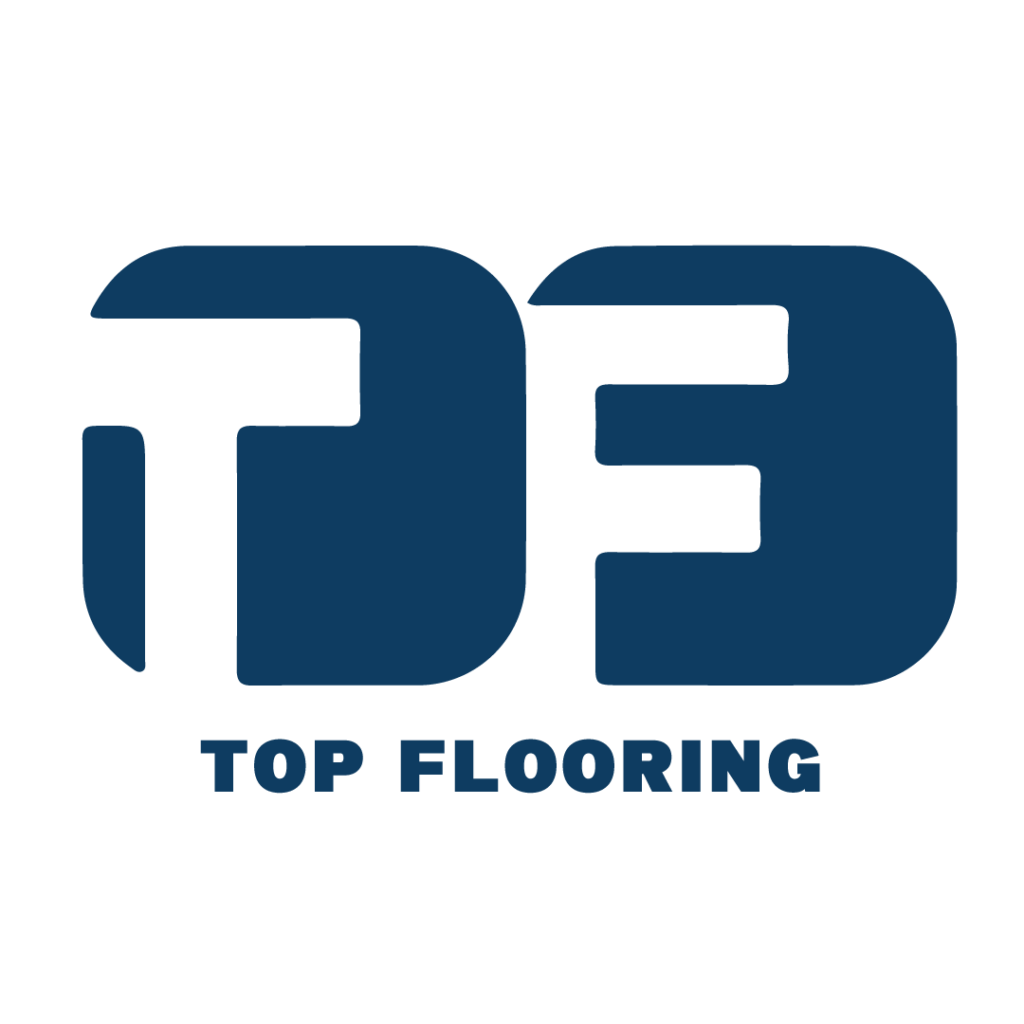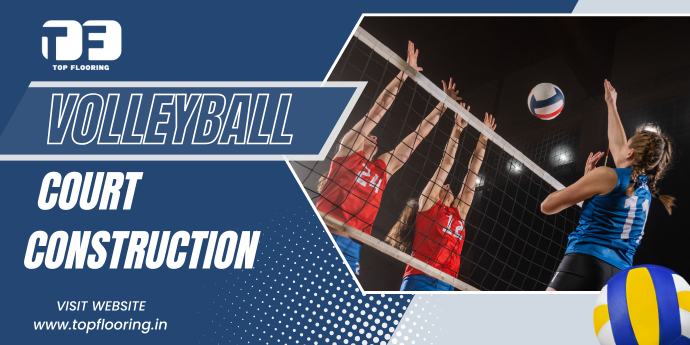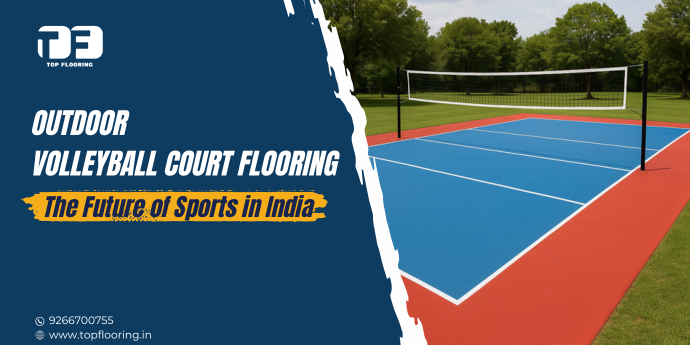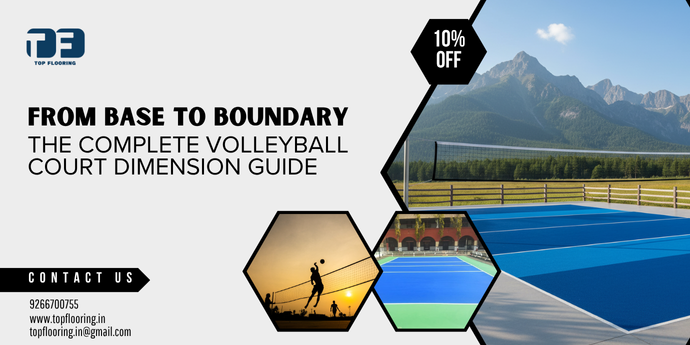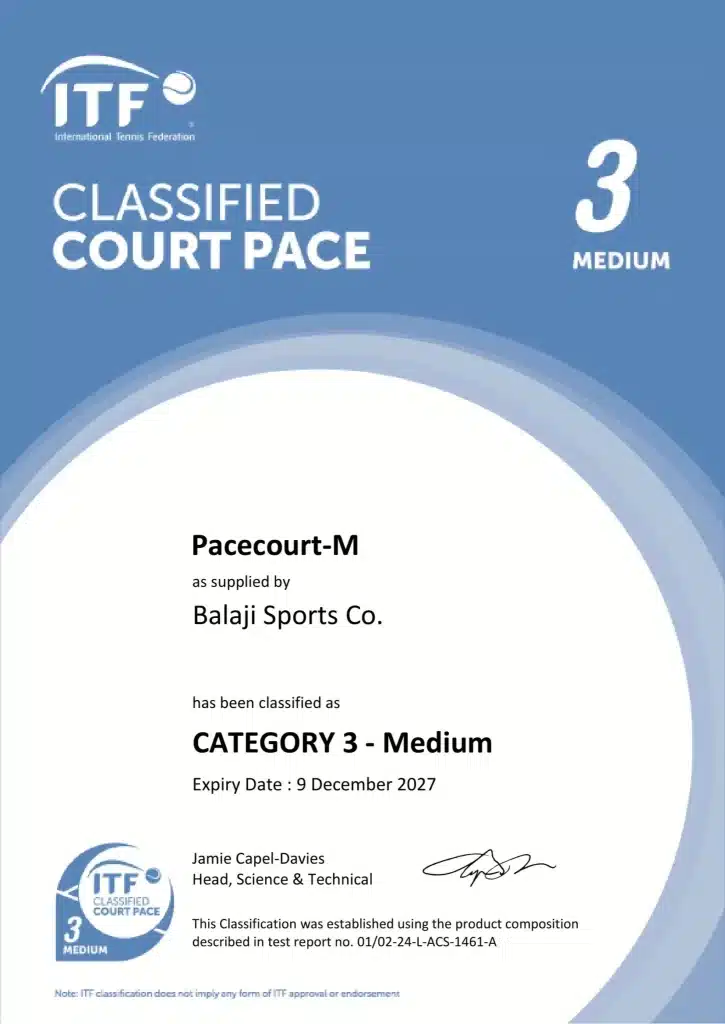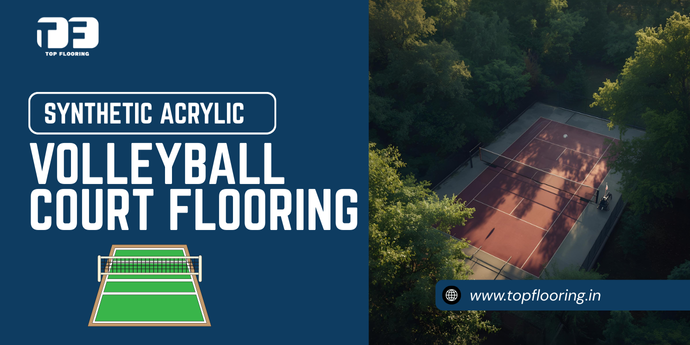
Volleyball is not limited to schools and beachside games, it’s one of the fastest growing sports in India. With the rise of sports academies, housing societies, colleges and recreational clubs, the demand for professional quality volleyball courts has increased. Today it’s not just about having a playing area; it’s about creating safe, durable and high performance courts that can withstand Indian climate conditions and meet international standards. Among the many sport flooring options available, synthetic acrylic volleyball court flooring stands out as the most cost effective and long lasting. Acrylic volleyball court systems are certified, weather resistant and low maintenance ideal for outdoor volleyball courts.
This blog covers everything you need to know about building a synthetic acrylic volleyball court in India: cost, benefits, maintenance and why acrylic is the preferred surface.
Why Choose Synthetic Acrylic Volleyball Courts?
The sports flooring material you choose is one of the most important decisions in volleyball court flooring. It not only affects player performance but also long term durability, safety and maintenance. Here’s a detailed look at why synthetic acrylic flooring is the best choice for outdoor volleyball court flooring in India:
1. Consistent Bounce & Grip
Acrylic volleyball courts are designed to deliver uniform ball bounce and superior grip. This ensures players experience predictable ball behavior during rallies, making the game fair and more competitive. The high grip volleyball court surface also reduces slips allowing athletes to move faster and with more confidence. For training academies and tournaments, this consistency improves skill development and professional level play.
2. Enhanced Shock Absorption
Volleyball involves quick jumps, landings and lateral movements all of which put stress on the body. Synthetic acrylic volleyball court construction with cushion layers provide shock absorption that reduces pressure on joints, ankles and knees. This minimizes fatigue and helps prevent common overuse injuries especially for athletes who spend long hours on the court. For schools and academies, cushioned volleyball courts are particularly valuable as they promote safe and injury free training.
3. All Weather Durability
India’s climate is unique with scorching summer heat and UV exposure and heavy monsoon rains. Synthetic acrylic volleyball flooring is designed to withstand these extremes without losing its playability or structural integrity. The UV resistant coatings prevent color fading and surface hardening while the drainage systems prevent waterlogging and cracks. This makes acrylic volleyball courts suitable for outdoor facilities across various regions in India.
4. Low Maintenance Advantage
Unlike wooden courts that need polishing or grass courts that require irrigation and trimming. Synthetic acrylic volleyball surfaces are low maintenance. Regular sweeping and occasional washing is enough to keep them in top condition. This reduces operational costs significantly over the court’s life. For clubs, schools and housing societies with limited budgets, this low maintenance nature is a big advantage compared to PVC or turf.
5. Certified Performance
Not all flooring systems are created equal. Acrylic flooring from trusted companies like Top Flooring comes with ITF and ISO certifications. Which means the courts meet international standards for ball bounce, surface grip and durability. Certified volleyball court systems provide assurance of quality, making them suitable for professional tournaments, school competitions and national level training facilities. For institutions looking to attract players and events, having a certified acrylic volleyball court is a mark of reliability and professionalism.
Top Flooring Synthetic Acrylic Volleyball Court Flooring Systems
5-Layer Acrylic System
The 5-layer acrylic system is a popular choice for schools, housing societies and community clubs who want a reliable court without breaking the bank. Although it’s more affordable than premium options, this system doesn’t compromise on performance or safety. It provides consistent bounce, excellent slip resistance and long lasting durability, making it perfect for regular training and recreational use. The system consists of one layer of acrylic resurfacer to prepare and smooth the base. Two layers of cushion coats that provide moderate shock absorption. And two layers of color coats with precision line markings that enhance UV resistance, grip and aesthetics. Institutions those who are looking for cost effective volleyball courts that meet international standards, this is a best option.
8-Layer Acrylic Cushion System
On the other hand, the 8-layer acrylic cushion system is designed for sports academies, universities and professional tournament venues. It offers a higher level of comfort and protection with five cushion layers that reduce fatigue and absorb impact, making it safer for players who train intensively. This flooring system reduces the risk of joint injuries while maintaining consistent ball response even under heavy use. The construction consists of one layer of acrylic resurfacer for base preparation. Five layers of cushion coats that deliver superior shock absorption. And two layers of color coats with professional line markings that ensures both durability and professional playability. Its resilience to extreme weather and heavy foot traffic makes it the premium choice for competitive volleyball courts.
Both systems provide durability and certified quality. But the 5-layer acrylic system provides a balance between affordability and reliability. While the 8-layer system delivers professional grade comfort and long term value. This flexibility allows Top Flooring to serve a wide range of clients, from community level players to professional athletes.
How Much Does It Cost To Make a Volleyball Court in India?
The cost to build a synthetic acrylic volleyball court in India depends on various components that add up to the total cost. The first one is usually base construction which includes site preparation, leveling and ensuring proper drainage for long term durability. Then comes the acrylic flooring system where clients can choose between 5-layer or 8-layer surfaces depending on their performance and comfort needs.
Lighting, fencing and windscreens also play a big role in the overall volleyball court project cost. Especially for facilities that will host evening games or official tournaments. Beyond the essentials branding, seating and custom court markings can add to the investment. But bring long term benefits in usability, aesthetics and player experience.
Instead of just looking at the initial cost, institutions and academies should view synthetic acrylic volleyball court construction as a long term investment. By understanding how the volleyball court construction cost are distributed across base preparation, flooring systems and add-ons. Clients can plan realistic budgets and make informed decisions without underestimating future requirements.
Maintenance & Resurfacing of Acrylic Volleyball Courts
Building a volleyball court is a long term investment and like any sports surface it requires regular care to maintain peak performance. Fortunately synthetic acrylic volleyball courts are designed for low maintenance compared to wooden or grass courts. They are both practical and cost efficient. Here’s a breakdown of the key maintenance practices:
Regular Cleaning of Volleyball Surface
Regular cleaning is essential to preserve the playability and appearance of the volleyball court. Dust, leaves and debris can accumulate on the volleyball surface reducing traction and creating hazards for players. In outdoor volleyball courts, stagnant water after rains must also be removed quickly to avoid volleyball court surface staining or long term damage. A simple regimen of sweeping, blowing leaves and occasional washing with mild detergent is usually enough to keep acrylic courts in top condition.
Periodic Inspection of Volleyball Court
Even the most durable volleyball court surfaces require periodic checks. Regular inspections help identify early signs of cracks, peeling or surface wear before they become big problems. This is especially important in areas with heavy monsoons or extreme heat. Where volleyball surface expansion and contraction can affect the flooring. Spotting small problems early allows for quick repairs and extends the life of the volleyball court.
Resurfacing of Volleyball Court
Resurfacing the volleyball court is part of long term court maintenance. Over time continuous play and exposure to weather will wear down the coatings affecting grip and bounce. Acrylic volleyball courts generally need resurfacing every 5 to 7 years depending on usage intensity and climate. This process restores the surface texture, renews color vibrancy and brings back the consistent ball response that players rely on.
Cost Efficiency in Volleyball Court
One of the biggest advantages of synthetic acrylic flooring is its cost of maintenance. Resurfacing volleyball flooring is more economical than the extensive repairs needed for wooden or natural grass courts. Which require frequent and costly maintenance. By choosing acrylic volleyball flooring, owners not only save on initial volleyball court installation. But also reduce lifecycle costs of the volleyball court making it the most cost efficient flooring solution in the long run.
Planned Resurfacing for Longevity
Instead of waiting for major surface problems in the volleyball court to appear. Planned resurfacing at regular intervals ensures the volleyball court remains professional, safe and visually appealing. Well maintained acrylic courts can last for a decade without major overhauls, schools, academies and clubs a reliable and long lasting sports surface.
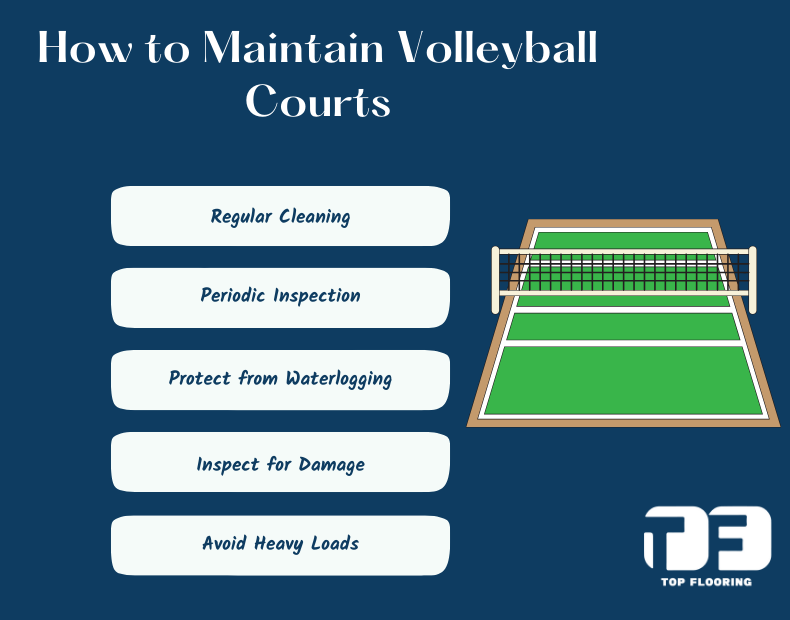
Synthetic Acrylic Volleyball Court vs Other Surfaces
When building a volleyball court, choosing the right surface for the volleyball court is one of the most important decisions. Each volleyball court flooring option like wood, PVC, clay, grass or acrylic has its own pros and cons. Below is a detailed comparison of how synthetic acrylic flooring stacks up against other popular court surfaces in India.
Wooden Flooring
Wooden volleyball flooring is considered the best standard for indoor volleyball courts because of its natural bounce and looks. It provides great grip and ball response, that’s why it’s a popular choice for professional indoor arenas. But wooden volleyball courts are very expensive to install and require continuous maintenance, including polishing, sanding and humidity control. In India’s climate where humidity and monsoons can damage wood quickly, wooden volleyball flooring often becomes a costly long term option.
PVC Flooring
PVC flooring is chosen for being affordable and easy to install, that’s why it’s a common solution for temporary or budget conscious courts. It performs reasonably well indoors, but PVC is not built to withstand heavy outdoor use. Under continuous play its surface wears out faster and exposure to UV rays can cause fading and cracking. For institutions looking for long lasting courts, PVC flooring ends up needing frequent replacements, increasing overall cost.
Grass or Clay Courts
Grass and clay are traditional volleyball surfaces, but they are less practical in India. It requires mowing, irrigation and daily maintenance to be playable, while clay needs constant sweeping, watering and leveling. Both surfaces struggle in monsoon heavy regions, where waterlogging makes them unusable. Also the uneven bounce of clay and grass courts makes them less suitable for professional training and tournaments.
Synthetic Acrylic Flooring
Synthetic acrylic flooring is the perfect balance of cost, durability, weather resistance and certified performance. These courts are ITF/ISO approved, ensuring consistent ball bounce, player comfort and safety. Acrylic volleyball courts are designed to handle extreme Indian climate, from scorching summers to heavy rains without losing grip or structural quality. They require far less maintenance than wooden, PVC or grass courts. Making them the most reliable and cost effective option in India for schools, academies, clubs and recreational facilities.
Why Choose Top Flooring?
When it comes to building volleyball courts that are reliable and long lasting, Top Flooring is one of the most trusted name in India’s sports infrastructure industry. The company combines quality with pan India presence. So every project meets professional standards and is cost effective.
- ITF/ISO certified flooring systems: One of the biggest advantages of choosing Top Flooring is its ITF and ISO certified flooring systems. These certifications ensure that every volleyball court meets international standards for safety, durability and performance. For schools, clubs, academies and professional facilities this gives peace of mind that the surface will give consistent bounce, grip and playability.
- Pan India service network: Top Flooring also stands out because of its pan India service network. While many volleyball court builders are metro focused. Top Flooring ensures timely project execution and after sales support in both urban and rural areas. This wide coverage makes it a preferred partner for organizations across the country.
- Affordable solutions: Affordability is another key factor. Unlike premium volleyball flooring which push high cost systems, Top Flooring provides cost effective solutions without compromising on quality. This balance allows institutions with varying budgets to get world class courts at reasonable prices.
- Proven track record: With a proven track record of delivering projects for schools, academies, housing societies and recreational clubs, Top Flooring has built a reputation for reliability and excellence.
- Custom built courts: Every volleyball court is custom designed to withstand Indian climate, from monsoon rains to scorching summers. So will get a long lasting and low maintenance volleyball court.
By combining experience, certification, affordability and pan India presence Top Flooring is the top choice for synthetic acrylic volleyball court construction in India.
Conclusion
Building a synthetic acrylic volleyball court in India is more than just a construction project – it’s an investment in sports excellence, community development and player safety. The cost may vary depending on court size, base preparation and additional features but synthetic acrylic flooring is the smartest choice. It gives unmatched durability, low maintenance and certified quality so it’s ideal for schools, academies, housing societies and professional facilities.
Get in touch with Top Flooring to build your ITF certified acrylic volleyball court today.
Frequently Asked Questions
A well-maintained synthetic acrylic volleyball court lasts 5–10 years before resurfacing is needed.
Yes. Acrylic flooring provides consistent bounce, grip, shock absorption, and weather resistance, making it ideal for volleyball courts.
Acrylic courts are durable, weather-resistant, and certified for professional play, while PVC courts are cheaper but wear out faster and suit indoor use only.
Acrylic surfaces are weather-resistant, UV-protected, and low maintenance, making them ideal for India’s hot summers and heavy monsoons.
Annual maintenance costs are minimal compared to clay or turf courts, mainly involving cleaning and occasional repairs.
Top Flooring is best for synthetic acrylic volleyball court flooring, offer ITF/ISO-certified acrylic systems tailored for Indian conditions.
